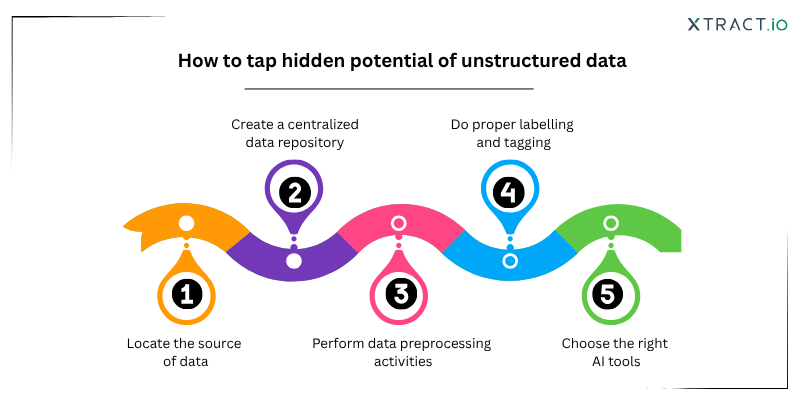By now, we all know the phrase “data is the new oil” like the back of our hands, but are you tapping into the richest reserves, or just skimming the surface by relying only on the most accessible data type, the structured data? If that is the case, think twice, because there is a bigger, messier, and much more valuable data trove, unstructured data.
In today’s digital first world, every transaction, conversation, and single action like a click is data. But keeping your data archived is no less than a crime; instead, it must be acted upon. Data becomes a game-changing superpower when it powers up, influences, and helps to arrive at confident decisions.
And the breakthrough in the data realm is unstructured data. Unstructured data is growing exponentially. Even as far back as 2020, Deloitte estimated that the number of digital data bits created globally was roughly equivalent to the number of stars in the universe. This staggering comparison captures just how massive and unwieldy the data landscape has become. Unstructured data is undeniably complex, and as it grows, so do the challenges of managing it. But within that complexity lies the key to deeper insights.
That’s where XDAS comes in, our AI-powered data automation suite built to help you tame unstructured data chaos and transform it into actionable outcomes.

So, why keep a close watch on unstructured data?
When managed effectively, it becomes a strategic asset that can enhance your entire decision-making process.
- Tap customer concerns and pain points before they even become trends.
- Anticipate risks before they even escalate into bottleneck moments.
- Unlock the camouflaged opportunities that can secure your enterprise a first-mover advantage.
And there’s so much more you can unlock from unstructured data. If you still think it is okay to leave your unstructured data untouched, it’s time to change your perspective. Ignoring unstructured data might not only snatch away your competitive advantage, but it might also add to expensive storage.
Now that you’ve decided to act on unstructured data, I can see a thought bubble above your head that reads “But how do I get started with unstructured data?”. Let me tell you how.
How to unleash the hidden intelligence of unstructured data
AI might be your key to unlock the power of unstructured data, but it is not magic. Language Models (LLMs) are often seen as the go-to solution for handling unstructured data. LLMs use technology called Natural Language Processing (NLP) to predict the next word by identifying patterns or trends in existing data. While they have proved their generative excellence, their results are not bulletproof. Their output reliability depends on the quality of the data we feed in. Hence, it is very important to present good-quality input to the AI, or to be precise, to make your data AI-ready. Only then can AI read, analyze, and deliver reliable results.
But, here is the catch: 57% of organizations cite preparing for AI as their most significant business challenge in unstructured data management, not because they lack tools, but because transforming messy, scattered data into AI-ready input is a whole different ballgame.
Suppose you are still trying to crack the code to make your data AI-ready. Let me share some best practices to prepare your data for AI. That’s where XDAS comes in, our AI-powered data automation suite built to help you tame unstructured data chaos and transform it into actionable outcomes.

Identify where your unstructured data lives
You have to locate your gold mine even before you start mining it. The first and crucial step in data preparation is identifying all possible sources where your unstructured data might be hiding. I say hiding because, unlike structured data, unstructured data is scattered across different systems, and there is a high chance of data leakage. Identifying all the relevant data points is vital because you need to present a complete database for the AI to consume. Incomplete data coverage will lead to a partial analysis, which can cascade into unreliable results.
Let me explain how crucial this step is through an example. You want to train your AI to streamline and optimize customer service. In the case of customer service, data related to customer interactions may be stored in call logs, emails, surveys, and other records. If you don’t identify all possible sources where you find relevant insightful data, you may only process data from a few obvious sources, leaving deeper insights behind. Instead, the best practice is to list all the sources where relevant data might be present, and prioritize the datasets based on their value.
Unify your dispersed data into a central repository
The next important step is to have a centralized repository to store all the dispersed unstructured data. This process might be very tiring if done manually, but data automation platforms like XDAS can easily automate the collection and consolidation of data using intelligent workflows. Since the data collection is automated, enterprises can focus on the further processes to increase data quality.
Perform frequent data preprocessing
Now, this is a make-or-break step because it predominantly focuses on improving the quality of data by making the data AI fit. Data formatting and standardization are the standard techniques to transform the data into an AI-readable format. But in case of unstructured data, the process is not that easy, hence there is a demand for technologies that include NLP, such as breaking text into smaller units (tokenization), standardizing words (stemming and lemmatization), eliminating irrelevant terms (stop word removal), and identifying key entities (named entity recognition) to make the data actionable and meaningful.
Label and tag unstructured data for AI
Once the data is cleaned, the datasets must be labeled and tagged. This step is essential in AI training, as it helps AI understand the context and enhances interpretation. For example, you want to leverage AI to classify customer feedback. In that case, you must provide context, such as how each feedback type sounds. You could also add tone, connotation, and commonly used words associated with each feedback type. Labelling with context can help AI understand patterns and detect when similar situations arise.
Since unstructured data does not fit any structure, contextual labelling is preferred over keyword labelling. Given the complexity of unstructured data, the better approach is to include the HITL component, wherein human experts use real-world context to annotate and label datasets. This way, the training data quality can be increased, which will ultimately improve the AI model’s performance. Methodologies such as text mining, sentiment analysis, and entity extraction can also enhance data quality further.
Choose the right AI tools
There is no rulebook; it is very simple. The better you prepare your unstructured data, the more AI can penetrate to extract the richest insights. Hence the choice of AI tools holds significant value in unstructured data processing. Businesses need to get a proper understanding of the nature of the data type and choose methodologies accordingly. For example, text-heavy data requires natural language processing (NLP), while image-intensive data requires computer vision.
Challenges that come along
While these steps bring you closer to AI-readiness, the road isn’t without bumps. Managing unstructured data is not an easy way out; it is resource, time and capital-intensive. The most obvious challenge of unstructured data management is that data cannot be fed directly to AI models due to its inherently noisy nature. Thereby, businesses leveraging unstructured data must invest in advanced technologies to make it AI-compatible.

Additionally, unstructured data contains sensitive information, so there might be serious considerations surrounding privacy and compliance. With the increasing data volumes, the scalability of unstructured data processing may be another hurdle. Integration is equally challenging, as unstructured data typically resides across diverse formats and disconnected systems, making it harder to unify and extract meaningful insights.
Still with me? Let’s talk solutions
Amidst all the downsides, there is still a growing interest in unstructured data processing because of the immense value it holds. To tap the complex unstructured data, you must invest in data automation solutions to help you extract the golden oil from unstructured data.
Tired of looking for the perfect data solution? Look no further, we’ve got XDAS.
XDAS simplifies unstructured data management with an AI-first, zero-code platform that extracts, cleans, and structures data from diverse formats like PDFs, emails, and websites. It offers built-in data pipelines, scalability, and human-in-the-loop accuracy, making it both efficient and reliable.
With seamless integrations, compliance-ready features, and domain-specific customization, XDAS enables businesses to turn unstructured data into ready-to-use, trustworthy insights without the typical resource or complexity burden. Curious to see XDAS in action? Let’s talk.
Finally, the future belongs to those who turn their unstructured gold mines into AI-fueled ecosystems. Your gold mine is waiting. Ready to unlock it?
The post How do you turn unstructured data chaos into actionable intelligence? appeared first on Blog | Xtract.io.

